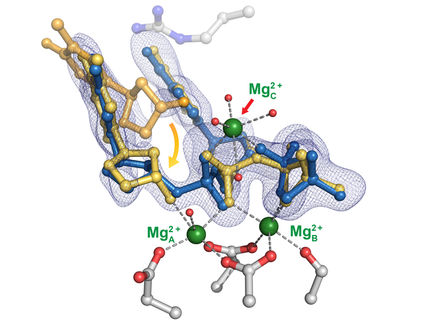For unzipping DNA mysteries - literally - Cornell physicists discover how a vital enzyme works
Advertisement
With an eye toward understanding DNA replication, Cornell researchers have learned how a helicase enzyme works to actually unzip the two strands of DNA (Nature, 2011).
At the heart of many metabolic processes, including DNA replication, are enzymes called helicases. Acting like motors, these proteins travel along one side of double-stranded DNA, prompting the strands to "zip" apart.
What had been a mystery was the exact mechanics of this vital biological process – how individual helicase subunits coordinate and physically cause the unzipping mechanism.
Cornell researchers led by Michelle Wang, professor of physics and an investigator of the Howard Hughes Medical Institute (HHMI), have observed these processes by manipulating single DNA molecules to watch what happens when helicases encounter them, and how different nucleotides that fuel the reactions affect the process. For their experiments they used an E. coli T7 phage helicase, a type with six distinct subunits, which is a good representation of how many helicases work.
"This is a great demonstration of the power of single-molecule studies," said Wang, whose lab specializes in a technique called optical trapping. To record data from single molecules, the scientists use a focused beam of light to "trap" microspheres attached to the molecules.
Prior to this work, researchers from other labs had found that the nucleotide dTTP (deoxythymidine triphosphate) was a "preferred" fuel for the helicase, and that the helicase apparently wouldn't unzip DNA if ATP (adenosine triphosphate) was provided as fuel. Wang and her colleagues found this puzzling, because ATP is known to be the primary fuel molecule in living organisms.
In their latest work, they discovered that, in fact, ATP does cause unwinding, but only in the single-molecule study could they confirm this. In normal biochemical studies, ATP doesn't seem to work, because it causes helicase to "slip" backward on the DNA, then move forward, then slip again.
In bulk studies, rather than single-molecule kinetic observations, the ATP doesn't produce a signal from unwound DNA because the slippage masks the signal.
They then surmised that different mixtures of nucleotides might allow them to investigate helicase subunit coordination. They found that very small amounts of dTTP mixed with large amounts of ATP were enough to decrease the "slippage" events they saw with the ATP alone.
Further inspection revealed that while two subunits of the T7 helicase are binding and releasing nucleotides, the other four can remain bound to nucleotides to anchor the DNA and prevent it from slipping. It only takes one subunit bound to dTTP to decrease slippage almost entirely – a little goes a long way.
Such studies can help scientists gain a deeper understanding of helicase mechanics and, in the case of medicine, what happens when helicases go awry or don't bind correctly.
Smita Patel, Rutgers University biochemistry professor and paper co-author, says helicase defects are associated with cancer predisposition, premature aging and many other genetics-related conditions.
"This study provides fundamental new knowledge about a cellular process that is essential to all forms of life," said Catherine Lewis, who oversees single-molecule biophysics grants at the National Institute of General Medical Sciences of the National Institutes of Health. "By using single-molecule methods to study how helicases work, Dr. Wang has resolved several longstanding questions about how the enzyme is coordinated, and possibly regulated, during replication."


























































